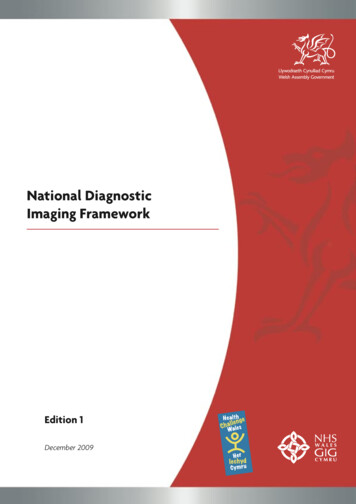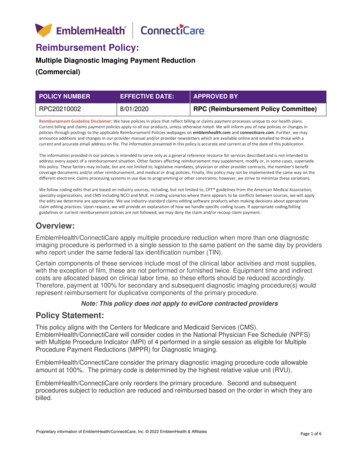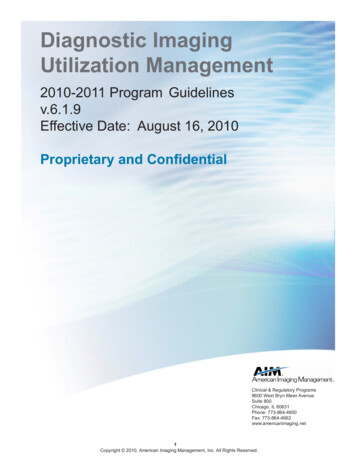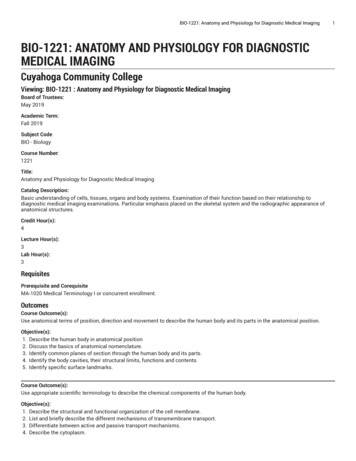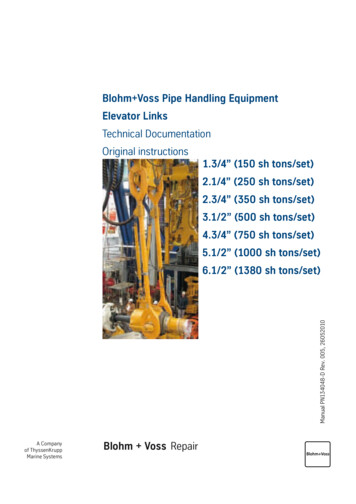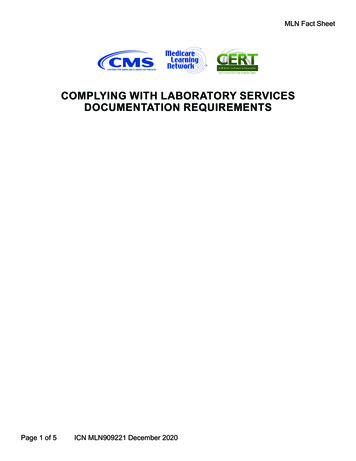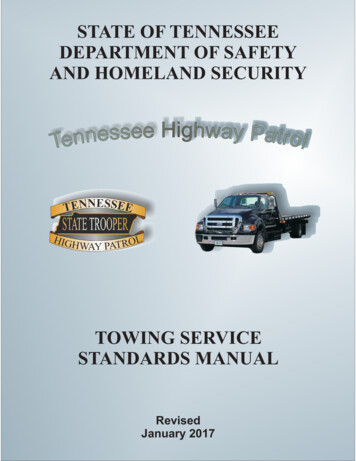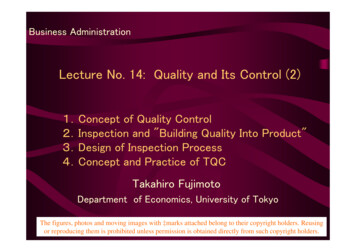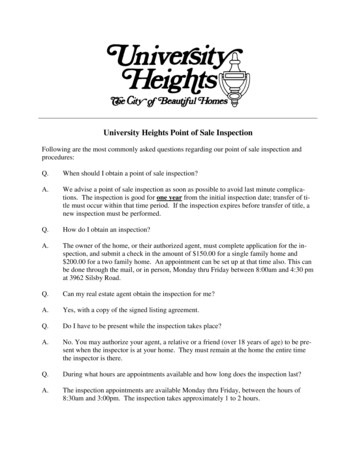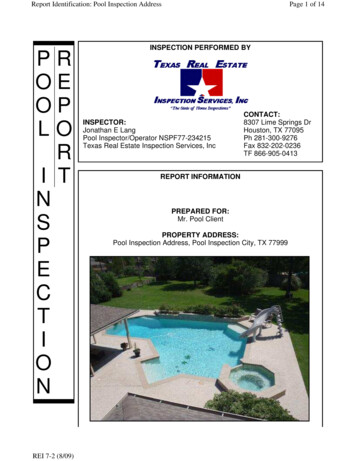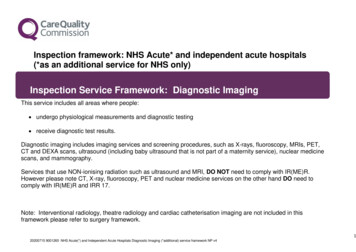
Transcription
Inspection framework: NHS Acute* and independent acute hospitals(*as an additional service for NHS only)Inspection Service Framework: Diagnostic ImagingThis service includes all areas where people: undergo physiological measurements and diagnostic testing receive diagnostic test results.Diagnostic imaging includes imaging services and screening procedures, such as X-rays, fluoroscopy, MRIs, PET,CT and DEXA scans, ultrasound (including baby ultrasound that is not part of a maternity service), nuclear medicinescans, and mammography.Services that use NON-ionising radiation such as ultrasound and MRI, DO NOT need to comply with IR(ME)R.However please note CT, X-ray, fluoroscopy, PET and nuclear medicine services on the other hand DO need tocomply with IR(ME)R and IRR 17.Note: Interventional radiology, theatre radiology and cardiac catheterisation imaging are not included in thisframework please refer to surgery framework.120200715 9001265 NHS Acute(*) and Independent Acute Hospitals Diagnostic Imaging (*additional) service framework NP v4
IMPORTANT – Prior to inspecting any service which included MRI or ionising radiation, you must be aware of therisks and follow the methods given to reduce your risk. For further information see the risk assessment and thediagnostic imaging ED modules.Areas to inspect*The inspection team should carry out an initial visual inspection of each area. Consider your observations alongside data andsurveillance to identify areas of risk or concern for further inspection. Diagnostic procedures1, for example EEG, echo, exercise test, chest pain clinicSample of imaging areas, e.g. plain film/ X-ray, CT, MRI, PET, ultrasound, nuclear medicineSample of physiological monitoring areas, e.g. respiratory clinicAreas where mammography takes placeInterviews, focus groups, observationsYou should conduct interviews of the following people at every inspection: Head of imaging services (in some cases there may be a manager for each area, that is MRI, CT, radiology) Radiation protection advisor2 (RPA - this person may not be on site as some providers have contracts with third parties to provide thisadvice) Radiation protection supervisor (RPS)Senior radiologist (This person may not be on site at the time of the inspection)Medical physics expertYou could gather information about the service from the following people, depending on the staffing structure:12Please note the relevant exclusions as some physiological tests not included within the definition of physiological measurement.RPA reports gathered ahead of the inspection may help to determine if you require the individual(s) for interview at inspection.220200715 9001265 NHS Acute(*) and Independent Acute Hospitals Diagnostic Imaging (*additional) service framework NP v4
Ultrasonographers and uclear medicine ARSAC licence holderDEXA techniciansAdministrative staff such as receptionSafeBy safe, we mean people are protected from abuse* and avoidable harm.*Abuse can be physical, sexual, mental or psychological, financial, neglect, institutional or discriminatory abuse.Key lines of enquiry: S1S1. How do systems, processes and practices keep people safe and safeguarded from abuse?Report sub-heading: Mandatory trainingPrompts S1.1 How are safety and safeguardingsystems, processes and practicesdeveloped, implemented and communicatedto staff?Professional standardSector specific guidance Are there statutory and mandatorytraining records? Have staff received training to makethem aware of the potential needs ofpeople with:o mental health needso learning disability needso autism needso dementia needsSkills for health core skills trainingframeworkS1.5 Do staff receive effective training insafety systems, processes and practices?320200715 9001265 NHS Acute(*) and Independent Acute Hospitals Diagnostic Imaging (*additional) service framework NP v4
Is there evidence that staff working withradiation have appropriate training in theregulations, radiation risks, and use ofradiation?Report sub-heading: Safeguarding S1.1 How are safety and safeguardingsystems, processes and practicesdeveloped, implemented and communicatedto staff? S1.2 How do systems, processes andpractices protect people from abuse, neglect,harassment and breaches of their dignity andrespect? How are these monitored and improved?S1.3 How are people protected fromdiscrimination, which might amount to abuseor cause psychological harm? This includesharassment and discrimination in relation toprotected characteristics under the EqualityAct.S1.4 How is safety promoted in recruitmentpractice, arrangements to support staff,disciplinary procedures, and ongoingchecks? (For example, Disclosure andBarring Service checks.) S1.5 Do staff receive effective training insafety systems, processes and practices? S1.6 Are there arrangements to safeguardadults and children from abuse and neglectthat reflect relevant legislation and localrequirements? Do staff understand their Safeguarding children and youngpeople: Roles and competencies forhealthcare staff (January 2019) Are staff aware of theirresponsibilities surrounding Femalegenital mutilation ?Adult safeguarding: Roles andcompetencies for healthcare staff(August 2018) HM Government: Working Together:Working together to safeguardchildren: A guide to inter-agencyworking to safeguard and promote thewelfare of children. July 2018If the service treats patients underthe age of 18 years are thereappropriate child safeguardingarrangements? Is information regardingsafeguarding from abuse displayedwhere service users will see it?The radiological investigation ofsuspected physical abuse in children Female genital mutilation multi-agencypractice guidelines published in 2016 DH Female Genital Mutilation andSafeguarding: Guidance forprofessionals March 2016 Guidelines for physicians on thedetection of child sexual exploitation(RCP, November 2015)Where children are seen or treated: Does the service ensure that all staffare trained to appropriate level setout in the Intercollegiate Frameworkand are familiar with Governmentguidance ‘Working Together toSafeguard Children’? Are staff able to access a named ordesignated professional (internal orexternal) for advice at all times 24hours a day?420200715 9001265 NHS Acute(*) and Independent Acute Hospitals Diagnostic Imaging (*additional) service framework NP v4
responsibilities and adhere to safeguardingpolicies and procedures, including working inpartnership with other agencies? CQC cross sector DBS guidance MHA 1983 Code of PracticeS1.7 Do staff identify adults and children atrisk of, or suffering, significant harm? How dothey work in partnership with other agenciesto ensure they are helped, supported andprotected? Is there an identifiable leadresponsible for co-ordinatingcommunication for children at risk ofsafeguarding issues? Do staff have an awareness of CSEand understand the law to detectand prevent maltreatment ofchildren? How do staff identify and respond topossible CSE offences? Are riskassessments used/in place? What safeguarding actions aretaken to protect possible victims ofCSE? Are timely referrals made?And is there individualised andeffective multi-agency follow up? Are leaflets available about CSEwith support contact details? What wider safeguardingprotocol/guidance is in place - howare safeguarding issues talkedabout, who manages them, arelessons learned etc.? Is there a chaperoning policy inplace for children and youngpeople? Are staff aware of andunderstand this policy?520200715 9001265 NHS Acute(*) and Independent Acute Hospitals Diagnostic Imaging (*additional) service framework NP v4
If a child/young person is identifiedas being on a child protection plan,what systems are in place to ensurethe correct information is sharedand actions put in place? Are there protocols in place forchildren with safeguardingconcerns?Report sub-heading: Cleanliness, infection control and hygiene S1.1 How are safety and safeguardingsystems, processes and practicesdeveloped, implemented and communicatedto staff? S1.8 How are standards of cleanliness andhygiene maintained? Are there reliablesystems in place to prevent and protectpeople from a healthcare-associatedinfection? NICE QS61 Statement 3: People receive healthcare from healthcareworkers who decontaminate theirhands immediately before and afterevery episode of direct contact or care. NICE QS61 Statement 4: People whoneed a urinary catheter have their riskof infection minimised by thecompletion of specified proceduresnecessary for the safe insertion and maintenance of the catheter and itsremoval as soon as it is no longerneeded. NICE QS61 Statement 5: People whoneed a vascular access device havetheir risk of infection minimised by thecompletion of specified proceduresnecessary for the safe insertion andmaintenance of the device and itsWhat precautions are taken in radiologysettings when seeing people withsuspected communicable diseases?E.g. TB or Flu etc.What infection control measures are inuse when carrying out a consultation / xray or performing a scan on peoplerequiring isolation? E.g. people withinfectious diarrhoea.What are the results of local cleaning /hand hygiene audits?Are appropriate cleaning procedures forultrasound probes, following an intimateexamination?620200715 9001265 NHS Acute(*) and Independent Acute Hospitals Diagnostic Imaging (*additional) service framework NP v4
removal as soon as it is no longerneeded. Health Technical Memorandum 01-01decontamination of surgicalinstruments (medical devices) used inacute care: -in-acute-careReport sub-heading: Environment and equipment HSE guidance on portable electricalequipment Is resuscitation equipmentreadily available? guidelines and legislation impact onmedical devices management S1.9 Do the design, maintenance and use offacilities and premises keep people safe? MHRA Managing medical devices S1.10 Do the maintenance and use ofequipment keep people safe? S1.11 Do the arrangements for managingwaste and clinical specimens keep peoplesafe? (This includes classification,segregation, storage, labelling, handling and,where appropriate, treatment and disposal ofwaste.)Assessing Controlled SubstancesHazardous to Health Regulations 2002Has the imaging service done a riskassessment for all new or modified useof radiation? Do the risk assessmentsaddress occupational safety as well asconsidering risks to people who useservices and public? Is all relevant MRI equipment labelledin line with MHRA recommendationse.g. MR Safe, MR Conditional, MRUnsafe? How does the imaging service ensurethat non-ionising and ionising radiationhave arrangements to control the areaand restrict access? S1.1 How are safety and safeguardingsystems, processes and practicesdeveloped, implemented and communicatedto staff? ment-in-clinical-use720200715 9001265 NHS Acute(*) and Independent Acute Hospitals Diagnostic Imaging (*additional) service framework NP v4
Is there clear signage where ionisingradiation exposures occurs? How does the service ensurespecialised personal protectiveequipment is available and used by staffand carers when needed? How do theycheck that the lead aprons, lead screensand syringe/vial shielding in nuclearmedicine? For example, are any annualchecks carried out on them? Does the provider undertakeassessments and reviews of theiractivities under the Control ofSubstances Hazardous to HealthRegulations 2002 (COSHH)? Does the provider have an equipmentQA programme and are they doing thison all x-ray equipment at the appropriatetime as recommended by the medicalphysics experts, or the manufacturersrecommendation? Are there appropriate service contractsin place for equipment? Is there a clearprocess for maintenance of equipmentand for reporting of any faults? Is therea process in place for the safe handoverof equipment? Does the service monitor staff forradiation exposure?820200715 9001265 NHS Acute(*) and Independent Acute Hospitals Diagnostic Imaging (*additional) service framework NP v4
In case of a service using radiation orradioactive substances are thereeffective arrangements in place tocontain the incident e.g. such asradioactive spillage while carrying outa PET-CT scan or another form ofnuclear medicine imaging?920200715 9001265 NHS Acute(*) and Independent Acute Hospitals Diagnostic Imaging (*additional) service framework NP v4
Key line of enquiry: S2S2. How are risks to people assessed, and their safety monitored and managed so they are supported to stay safe?Report sub-heading: Assessing and responding to patient riskPromptsProfessional standardSector specific guidance Sepsis: recognition, diagnosis andearly management (NICE Guideline51) Is there a policy for sepsis managementand are staff aware of it? National Safety Standards forInvasive Procedures (NatSSIPs)Version number: 1 published: 7September 2015 Brief guide: NatSSIPs and LocSSIPs Standards for the communication ofradiological reports and fail-safe alert S2.5 Are comprehensive risk assessmentscarried out for people who use services andrisk management plans developed in linewith national guidance? Are risks managedpositively?S2.6 How do staff identify and respondappropriately to changing risks to peoplewho use services, including deterioratinghealth and wellbeing, medical emergenciesor behaviour that challenges? Are staff ableto seek support from senior staff in thesesituations? HSIB report on communicatingunexpected significant findings Guidance on implementing safetychecklists for radiological procedures If children are treated there should bespecific paediatric protocols in placefor all imaging modalities. Are there clear pathways and processesfor the management of people usingservices within radiology departmentswho are clinically unwell and requirehospital admission? Are there processes to ensure the rightperson gets the right radiological scan atthe right time? Does the service follow the RCRstandards for the communication ofradiological reports and fail-safe alertnotification? Does the service check three points of IDand/or use the society of radiographers“pause and check”? Are there clear pathways andprocesses for staff to assessoutpatients using services in radiologydepartments who are clinically unwelland need hospital admission?1020200715 9001265 NHS Acute(*) and Independent Acute Hospitals Diagnostic Imaging (*additional) service framework NP v4
Notes for guidance on the clinicaladministration ofRadiopharmaceuticals and use ofsealed Radioactive Sources:Guidance on the clinicaladministration ofRadiopharmaceuticals and use ofsealed radioactive sources How does the imaging serviceensure that the radiation protectionadvisor and the medical physicsexpert are easily accessible forproviding radiation advice? Has the service appointed radiationprotection supervisors, In departmentswhich uses ionising radiation? The employer’s written procedures forexposures must include procedures—How does the service ensure that the‘requesting’ of an X-ray, nuclearmedicine or other radiation diagnostictest, e.g. by GP’s or others is only madeby staff / persons in accordance withIR(ME)R? Does the service adoptreferral criteria? (d) to ensure that quality assuranceprogrammes in respect of writtenprocedures, written protocols, andequipment are followed;Do staff do a debrief or give othersupport after aggressive or violentincidents? How does the imaging service ensurethat women (including patients andstaff) who are or may be pregnantalways inform a member of staffbefore they are exposed to anyradiation in accordance with IR(ME)Rand for staff in accordance with IRR? Is there a pregnancy procedure inplace? What are the local policies for the risk Protecting pregnant patients duringdiagnostic medical-exposures The impact of IR(ME)R 2017 onpregnancy checking procedures IRMER Regulations 2017, Schedule 2should be in place:(k) to ensure that the probability andmagnitude of accidental or unintendedexposure to individuals fromradiological practices are reduced sofar as reasonably practicable guidance on gadolinium basedcontrast agent administration in adultpatients1120200715 9001265 NHS Acute(*) and Independent Acute Hospitals Diagnostic Imaging (*additional) service framework NP v4
RCR endorsement of the 2016RANZCR Iodinated ContrastGuidelines which can be viewed ontrast-guidelines rsions/safety in magnetic resonance imaging 3.pdf assessment and prevention ofcontrast-induced nephropathy? Arethey in keeping with NICE Acutekidney injury guidelines and the RoyalCollege of Radiologists standards forintravascular contrast agentadministration? The potential risks of intravascularadministration of contrast must beweighed against the potential benefits.Systems need to be in place including trained individuals that are able torecognise and treat severe contrastreactions, including anaphylaxis. Thiscould be a registered nurseor radiographer or other appropriatelytrained healthcare professional. Do they use SCoR Pause and Check,or a similar version adapted by theorganisation? Guide to IRMERCancer NICE guidance CG151: Neutropenicsepsis: prevention and managementin people with cancer What are the local policies todocument, investigate, and make areferral to a specialist allergy serviceand the process for advising thepatient in cases where significantsuspected contrast reactions aresuspected?Are there clear processes to escalateunexpected or significant findings bothat the examination and uponreporting? How are these flagsescalated where reported byteleradiology services?Are there procedures for the collapseof a patient in MRI, and are thesepractised? Have managers ensured that there is aplan in place to develop local SafetyStandards for Invasive Procedures usingthe national Safety Standards forInvasive Procedures. Have theyassessed the need for these against allinvasive procedures carried out? i.e. for1220200715 9001265 NHS Acute(*) and Independent Acute Hospitals Diagnostic Imaging (*additional) service framework NP v4
US guided drainages or CT guidedbiopsies Do they have processes in place to directpatients as to what to do if they have acomplication post procedure? Are there local rules (IRR) andemployers procedures (IR(ME)R)which protect staff and patients fromionising radiation? For services that treat children, whatadditional wider arrangements are therein place to manage a deteriorating child?For example if a child needs a crashteam. How are staffing requirements assessedor calculated? Do they use agency? What are the localinduction policies? Does the provider carry out riskassessments to minimise risksassociated with lone working? For services that treat children, isthere access to a member of staff skilledin Advanced or European Paediatric LifeSupport?Report sub-heading: Staffing S2.1 How are staffing levels and skill mixplanned and reviewed so that people receivesafe care and treatment at all times and staffdo not work excessive hours?Cancer Health Education England – CancerWorkforce PlanS2.2 How do actual staffing levels and skillmix compare with the planned levels? Iscover provided for staff absence?S2.3 Do arrangements for using bank,agency and locum staff keep people safe atall times?1320200715 9001265 NHS Acute(*) and Independent Acute Hospitals Diagnostic Imaging (*additional) service framework NP v4
S2.4 How do arrangements for handoversand shift changes ensure that people aresafe?Cancer How does the provider ensure adequatediagnostic staffing, identified by HealthEducation England as experiencingshortages in the provision of cancerservices:o Clinical Radiologyo Diagnostic RadiographyS2.7 How is the impact on safety assessedand monitored when carrying out changes tothe service or the staff?Report sub-heading: Medical staffing S2.1 How are staffing levels and skill mixplanned and reviewed so that people receivesafe care and treatment at all times and staffdo not work excessive hours? S2.2 How do actual staffing levels and skillmix compare with the planned levels? Iscover provided for staff absence?S2.3 Do arrangements for using bank,agency and locum staff keep people safe atall times? Where intravascular contrastadministration is carried out, systemsneed to be in place including trainedindividuals that are able to recogniseand treat severe contrast reactions,including anaphylaxis. This could be aregistered nurse or radiographer orother appropriately trained nistrationadult-patients-third-editionS2.4 How do arrangements for handoversand shift changes ensure that people aresafe? Can the radiographers contact aradiologist for advice as the radiologistmay not always be onsite? How are staffing requirementsascertained? Do they use agency? What are the localinduction policies? Does the provider carry out riskassessments to minimise risksassociated with lone working? Does the service use teleradiologyservices for out of hours work and/ornormal reporting? Is there access tothese radiologists? Is there access to an appropriatelytrained clinician when contrast isadministered?S2.7 How is the impact on safety assessedand monitored when carrying out changes tothe service or the staff?1420200715 9001265 NHS Acute(*) and Independent Acute Hospitals Diagnostic Imaging (*additional) service framework NP v4
Key line of enquiry: S3S3. Do staff have all the information they need to deliver safe care and treatment to people?PromptsProfessional standardSector specific guidanceReport sub-heading: Records S3.1 Are people’s individual care records,including clinical data, written and managedin a way that keeps people safe? S3.2 Is all the information needed to deliversafe care and treatment available to relevantstaff in a timely and accessible way? (Thismay include test and imaging results, careand risk assessments, care plans and casenotes.) S3.3 When people move between teams,services and organisations (which mayinclude at referral, discharge, transfer andtransition), is all the information needed fortheir ongoing care shared appropriately, in atimely way and in line with relevantprotocols?S3.4 How well do the systems that manageinformation about people who use servicessupport staff, carers and partner agencies todeliver safe care and treatment? (Thisincludes coordination between differentelectronic and paper-based systems andappropriate access for staff to records.) Records management code ofpractice for health and social care ity-statement-3Information-exchange GMC guidance on keeping records NICE QS121 Statement 3: Peopleprescribed an antimicrobial have theclinical indication, dose and durationof treatment documented in theirclinical record. Standards for the provision ofteleradiology Brief guide on teleradiology Does the service provideelectronic access to diagnosticresults? How does the service ensure imagingrequests are appropriate and includethe relevant information to allow forrequests to be justified in accordancewith IR(ME)R? Does this includeinformation relevant to keep patientssafe? Where appropriate, is patientinformation transported with patientswhen attending a scan or procedure?Are staff aware of relevant clinical andcare requirements i.e. Fallassessments, DNACPR, NBM,pregnancy, renal function if contrast isto be used?As part of the justification process tocarry out exposure to radiation, howdoes the imaging service attempt tomake use of previous images of thesame persons requiring the test, even ifthese have been taken elsewhere?1520200715 9001265 NHS Acute(*) and Independent Acute Hospitals Diagnostic Imaging (*additional) service framework NP v4
When appropriate, do recordscontain details of patients’o mental health needso learning disability needso autism needso dementia needsalongside their physical health needs? Does the service have processes toensure that transport of patients toradiology includes relevant clinicalinformation e.g. infection risks or resusinfo or escort and porteringrequirements? Where used, is there a secure transferof data to and from teleradiologycompanies? Where there are multiple IT systems,how do they ensure information isshared and accessed when required?Independent healthcare: Is there a system in place to ensure thatmedical records generated by staffholding practising privileges areavailable to staff (or other providers)who may be required to provide care ortreatment to the patient?Cancer1620200715 9001265 NHS Acute(*) and Independent Acute Hospitals Diagnostic Imaging (*additional) service framework NP v4
Is there an adequate system to ensurethe diagnostic service’s access to cancerpatient records, whether paper orelectronic? If there are there multiple IT systems i.e.Electronic Patient Records and aseparate cancer information system, howdoes the service ensure timely transferof information between them?1720200715 9001265 NHS Acute(*) and Independent Acute Hospitals Diagnostic Imaging (*additional) service framework NP v4
Key line of enquiry: S4S4. How does the provider ensure the proper and safe use of medicines, where the service is responsible?PromptsProfessional standardSector specific guidance Are contrast media and othermedicines stored correctly? Are Patient Group Directions inplace, or are medicines prescribedby doctors or registered non-medicalprescribers? What processes are there to ensurethat the right radiopharmaceuticaland activity is sourced, prepared andinjected? Do radiologists hold appropriateARSAC licenses for theadministration of each radioactivemedicinal product?Report sub-heading: Medicines S4.1 How are medicines and medicinesrelated stationery managed (that is, ordered,transported, stored and disposed of safelyand securely)? (This includes medical gasesand emergency medicines and equipment.)S4.2 Are medicines appropriately prescribed,administered and/or supplied to people inline with the relevant legislation, currentnational guidance or best availableevidence?S4.3 Do people receive specific advice abouttheir medicines in line with current nationalguidance or evidence?S4.4 How does the service make sure thatpeople receive their medicines as intended,and is this recorded appropriately?S4.5 Are people's medicines reconciled inline with current national guidance ontransfer between locations or changes inlevels of care?S4.6 Are people receiving appropriatetherapeutic drug and physical healthmonitoring with appropriate follow-up inaccordance with current national guidance orevidence? NICE QS121 Statement 4: Peoplein hospital who are prescribed anantimicrobial have a microbiologicalsample taken and their treatmentreviewed when the results areavailable.Start Smart then Focus:Antimicrobial Stewardship ToolkitRCR guidance on sedation,analgesia and anaesthesia in theradiology department otes-for-guidance Products administered withradiopharmaceuticals can be done bya non-healthcare profession: Is there clear delegation for injectingradiopharmaceuticals Is this clearlydocumented?Guidance for the administration ofmedicinal products by non-medicalpersonnel Where medicines are administered inconjunction with a radioactive medicinalproduct, is this undertaken safely asspecified by the Human MedicinesRegulations 2012 as amended?1820200715 9001265 NHS Acute(*) and Independent Acute Hospitals Diagnostic Imaging (*additional) service framework NP v4
S4.7 Are people’s medicines regularlyreviewed including the use of ‘when required’medicines?S4.8 How does the service make sure thatpeople’s behaviour is not controlled byexcessive or inappropriate use of medicines? How is the use of medicines such asfurosemide risk assessed anddocumented so it can be administered bystaff?1920200715 9001265 NHS Acute(*) and Independent Acute Hospitals Diagnostic Imaging (*additional) service framework NP v4
Key line of enquiry: S5& S6S5. What is the track record on safety?S6. Are lessons learned and improvement made when things go wrong?PromptsProfessional standardSector specific guidanceReport sub-heading: Incidents S5.1 What is the safety performance overtime? S5.2 How does safety performance comparewith other similar services? S5.3 How well safety is monitored usinginformation from a range of sources(including performance against safety goalswhere appropriate)? S6.1 Do staff understand theirresponsibilities to raise concerns, to recordsafety incidents, concerns and near misses,and to report them internally and externally,where appropriate? S6.2 What are the arrangements forreviewing and investigating safety andsafeguarding incidents and events whenthings go wrong? Are all relevant staff,services, partner organisations and peoplewho use services involved in reviews andinvestigationsS6.3 How are lessons learned, and themesidentified and is action taken as a result ofinvestigations when things go wrong? A never event is a serious incidentthat is wholly preventable asguidance, or safety recommendationsproviding strong systemic protectivebarriers, are available at a nationallevel, and should have beenimplemented by all providers. Theevent has the potential to causeserious patient harm or death, hasoccurred in the past and is easilyrecognisable and clearly defined.never-events-policy-and-frameworkNever events 2018 Serious Incidents (SIs) should beinvestigated using the SeriousIncident Framework 2015. (NICE QS66 Statement 4): For adultswho receive intravenous (IV) fluidtherapy in hospital, clear incidents offluid mismanagement are reported ascritical incide
2 20200715 9001265 NHS Acute(*) and Independent Acute Hospitals Diagnostic Imaging (*additional) service framework NP v4 IMPORTANT - Prior to inspecting any service which included MRI or ionising radiation, you must be aware of the
